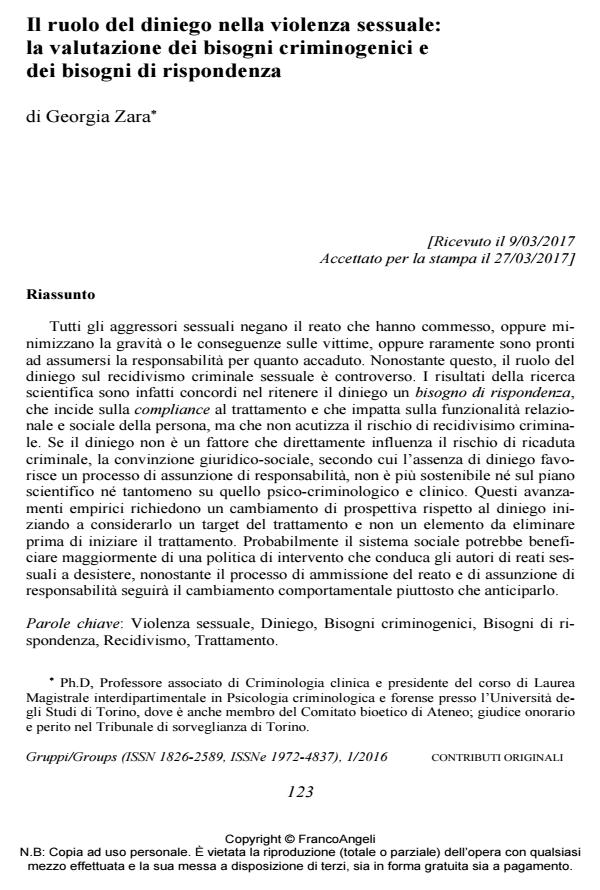Il ruolo del diniego nella violenza sessuale: la valutazione dei bisogni criminogenici e dei bisogni di rispondenza
Titolo Rivista GRUPPI
Autori/Curatori Georgia Zara
Anno di pubblicazione 2017 Fascicolo 2016/1
Lingua Italiano Numero pagine 18 P. 123-140 Dimensione file 240 KB
DOI 10.3280/GRU2016-001010
Il DOI è il codice a barre della proprietà intellettuale: per saperne di più
clicca qui
Qui sotto puoi vedere in anteprima la prima pagina di questo articolo.
Se questo articolo ti interessa, lo puoi acquistare (e scaricare in formato pdf) seguendo le facili indicazioni per acquistare il download credit. Acquista Download Credits per scaricare questo Articolo in formato PDF

FrancoAngeli è membro della Publishers International Linking Association, Inc (PILA)associazione indipendente e non profit per facilitare (attraverso i servizi tecnologici implementati da CrossRef.org) l’accesso degli studiosi ai contenuti digitali nelle pubblicazioni professionali e scientifiche
Tutti gli aggressori sessuali negano il reato che hanno commesso, oppure minimizzano la gravità o le conseguenze sulle vittime, oppure raramente sono pronti ad assumersi la responsabilità per quanto accaduto. Nonostante questo, il ruolo del diniego sul recidivismo criminale sessuale è controverso. I risultati della ricerca scientifica sono infatti concordi nel ritenere il diniego un bisogno di rispondenza, che incide sulla compliance al trattamento e che impatta sulla funzionalità relazionale e sociale della persona, ma che non acutizza il rischio di recidivisimo criminale. Se il diniego non è un fattore che direttamente influenza il rischio di ricaduta criminale, la convinzione giuridico-sociale, secondo cui l’assenza di diniego favo-risce un processo di assunzione di responsabilità, non è più sostenibile né sul piano scientifico né tantomeno su quello psico-criminologico e clinico. Questi avanzamenti empirici richiedono un cambiamento di prospettiva rispetto al diniego iniziando a considerarlo un target del trattamento e non un elemento da eliminare prima di iniziare il trattamento. Probabilmente il sistema sociale potrebbe beneficiare maggiormente di una politica di intervento che conduca gli autori di reati sessuali a desistere, nonostante il processo di ammissione del reato e di assunzione di responsabilità seguirà il cambiamento comportamentale piuttosto che anticiparlo.
Parole chiave:Violenza sessuale, Diniego, Bisogni criminogenici, Bisogni di rispondenza, Recidivismo, Trattamento.
Georgia Zara, Il ruolo del diniego nella violenza sessuale: la valutazione dei bisogni criminogenici e dei bisogni di rispondenza in "GRUPPI" 1/2016, pp 123-140, DOI: 10.3280/GRU2016-001010